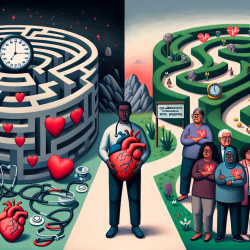Breaking the Stigma: A Data-Driven Approach to Mental Health in Schools
Mental health issues among young people are a growing concern, with an estimated 14.4% of individuals aged 10 to 24 experiencing mental disorders. Despite the prevalence, stigma remains a significant barrier to accessing care. The recent research article, Interventions to reduce stigma towards mental disorders in young people: protocol for a systematic review and meta-analysis, sheds light on effective strategies to combat this stigma.
Understanding the Impact of Stigma
Stigma towards mental disorders can manifest as public stigma, structural discrimination, interpersonal stigma, and self-stigma. These forms of stigma can severely impact young people's self-esteem, self-efficacy, and willingness to seek help. Addressing stigma is crucial for improving mental health outcomes and ensuring that young people receive the support they need.
Effective Interventions: What the Data Shows
The systematic review and meta-analysis highlighted several effective interventions for reducing stigma in young people:
- Social Contact: Direct interaction with individuals who have experienced mental health issues can help reduce stereotypes and prejudices.
- Educational Programs: Providing information through books, videos, and lectures can counteract stigma by increasing knowledge and changing attitudes.
- Media Campaigns: Utilizing media to challenge stigmatizing narratives and promote positive stories about mental health.
These interventions, particularly when implemented in educational settings, have shown promise in improving knowledge and attitudes towards mental health. However, the evidence on behavioral changes remains limited, indicating a need for further research and innovative approaches.
Implementing Change: The Role of Practitioners
Practitioners play a critical role in implementing stigma-reducing interventions. Here are some actionable steps for practitioners:
- Integrate Stigma Reduction into Curriculum: Schools can incorporate mental health education into their curricula, using evidence-based materials to educate students about mental health.
- Promote Open Discussions: Encourage open dialogues about mental health in classrooms to normalize conversations and reduce stigma.
- Leverage Online Platforms: Utilize online therapy services, like those offered by TinyEYE, to provide accessible mental health support and education.
By adopting these strategies, practitioners can create a more supportive environment for young people, fostering a culture of understanding and acceptance.
Encouraging Further Research
While the current research provides valuable insights, it also highlights the need for further studies to explore the long-term impact of stigma-reducing interventions. Practitioners and researchers are encouraged to collaborate on developing and testing new strategies that address both knowledge and behavior change.
To read the original research paper, please follow this link: Interventions to reduce stigma towards mental disorders in young people: protocol for a systematic review and meta-analysis.










